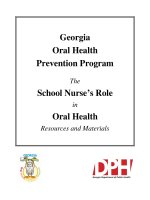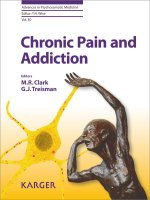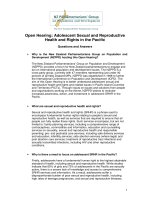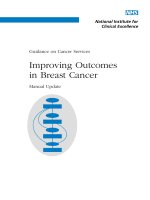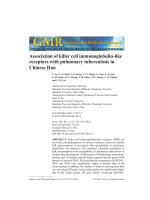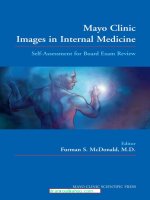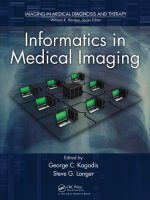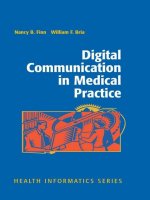LIVER BIOPSY IN MODERN MEDICINE pdf
Bạn đang xem bản rút gọn của tài liệu. Xem và tải ngay bản đầy đủ của tài liệu tại đây (26.69 MB, 388 trang )
LIVER BIOPSY IN
MODERN MEDICINE
Edited by Yoshiaki Mizuguchi
Liver Biopsy in Modern Medicine
Edited by Yoshiaki Mizuguchi
Published by InTech
Janeza Trdine 9, 51000 Rijeka, Croatia
Copyright © 2011 InTech
All chapters are Open Access distributed under the Creative Commons Attribution 3.0
license, which permits to copy, distribute, transmit, and adapt the work in any medium,
so long as the original work is properly cited. After this work has been published by
InTech, authors have the right to republish it, in whole or part, in any publication of
which they are the author, and to make other personal use of the work. Any republication,
referencing or personal use of the work must explicitly identify the original source.
As for readers, this license allows users to download, copy and build upon published
chapters even for commercial purposes, as long as the author and publisher are properly
credited, which ensures maximum dissemination and a wider impact of our publications.
Notice
Statements and opinions expressed in the chapters are these of the individual contributors
and not necessarily those of the editors or publisher. No responsibility is accepted for the
accuracy of information contained in the published chapters. The publisher assumes no
responsibility for any damage or injury to persons or property arising out of the use of any
materials, instructions, methods or ideas contained in the book.
Publishing Process Manager Mirna Cvijic
Technical Editor Teodora Smiljanic
Cover Designer Jan Hyrat
Image Copyright Sebastian Kaulitzki, 2011. Used under license from Shutterstock.com
First published September, 2011
Printed in Croatia
A free online edition of this book is available at www.intechopen.com
Additional hard copies can be obtained from
Liver Biopsy in Modern Medicine, Edited by Yoshiaki Mizuguchi
p. cm.
ISBN 978-953-307-883-0
free online editions of InTech
Books and Journals can be found at
www.intechopen.com
Contents
Preface IX
Part 1 Liver Biospy in Management of Liver Disease 1
Chapter 1 Liver Biopsy in Transplantation:
Nonalcoholic Fatty Liver Disease and the Eosinophils 3
Kishi, Sugawara and Kokudo
Chapter 2 Histopathological Diagnosis of Non-Alcoholic
and Alcoholic Fatty Liver Disease 13
Andrea Tannapfel and Berenike Flott-Rahmel
Chapter 3 Metabolic Steatosis & Fibrosis:
Review of the Non-Invasive
Tools for Diagnosis and Screening 35
Miette Véronique, Abdennour Meriem,
Sandrin Laurent and Sasso Magali
Chapter 4 Reversal of Liver Fibrosis:
A Review 63
Mona H. Ismail
Chapter 5 Hepatic Oxidative Stress: Role of Liver Biopsy 77
Mahmoud Rushdi Abd Ellah
Chapter 6 Clinical Variants of Primary Sclerosing Cholangitis:
When Does Liver Biopsy Make the Diagnosis? 89
Annarosa Floreani
Chapter 7 Evaluation of Radiofrequency Ablation
as a Method for Treatment of Hepatocellular Carcinoma 95
Heba Mohamed Abdella
Chapter 8 Percutaneous Liver Fiducial Implants:
Techniques, Materials and Complications 107
David Roberge and Tatiana Cabrera
VI Contents
Chapter 9 Drugs and Toxins Effects on the Liver 117
Piero Luigi Almasio, Anna Licata and Claudia Randazzo
Chapter 10 Adverse Effects of Drugs and Toxins on the Liver 137
Jan Schjøtt
Part 2 Liver Biopsy in Transplantation 163
Chapter 11 The Liver Biopsy During Organ Procurement 165
Johannes W. Rey and Jochen W.U. Fries
Chapter 12 Initial Poor Graft Dysfunction
and Primary Graft Non-Function
After Orthotopic Liver Transplantation 183
Chen Hao, Xie Junjie, Shen Baiyong, Deng Xiaxing,
Tao Ran, Peng Chenghong and Li Hongwei
Chapter 13 Role of Liver Biopsy After Liver Transplantation 207
Marco Carbone and James Neuberger
Chapter 14 Immunohistochemical Staining of Liver Grafts
for Recurrent Hepatitis C After Liver transplantation 219
Hiroshi Sadamori, Tetsuya Ogino,
Takahito Yagi and
Toshiyosi Fujiwara
Chapter 15 The Present Role of Liver Biopsy
in Kidney Transplant Candidates
in the Management of Hepatitis B and C Patients 229
Teresa Casanovas, Carme Baliellas
and Maria Carmen Peña Cala
Part 3 Liver Biopsy in Children 251
Chapter 16 Needle Biopsy in Children With Liver Diseases 253
Pietrobattista A.,
Alterio A., Natali G., Fruhwirth R.,
Comparcola D., Sartorelli M.R. and Nobili V.
Chapter 17 Liver Biopsy as a Useful Tool in the Management of
Autoimmune Liver Diseases in Childhood 265
Giuseppe Maggiore, Marco Sciveres and Aurelio Sonzogni
Chapter 18 Bile Duct Paucity in Infancy 295
Consolato Sergi, Wesam Bahitham and Redha Al-Bahrani
Part 4 Viral Hepatitis 305
Chapter 19 Occult Hepatitis C Virus Infection: Where are We Now? 307
Nicot Florence, Kamar Nassim, Rostaing Lionel and Izopet Jacques
Contents VII
Chapter 20 Hepatitis C Virus Proteins Induce Cirrhosis Antigen
Expression on Human Hepatoma Cells In Vitro: Implications
for Viral Mechanisms in Hepatitis C Fibrogenesis 335
Alka Saxena, Sampa Pal, Stephen J. Polyak, Sy Nakao, Igor
Tikonokov, Tao Su, Thao Tran, Wan Chong Qiu, Jessica Wagoner,
Lisa Thomassen, Margaret Shuhart and David R. Gretch
Chapter 21 New Aspects of Natural History and Pathogenicity
of Hepadnaviral Infection and Hepatocyte Function
Revealed by the Woodchuck Model of Hepatitis B 355
Patricia M. Mulrooney-Cousins and Tomasz I. Michalak
Preface
Liver biopsy, first performed by Paul Ehrlich in 1883, remains an important diagnostic
procedure for the management of hepatobiliary disorders and the candidate/donated
organ for transplantation. The book "Liver biopsy in Modern Medicine" comprises 21
chapters covering the various aspects of the biopsy procedure in detail and provides
an up-to-date insightful coverage to the recent advances in the management of the
various disorders with liver biospy. This book will keep up with cutting edge
understanding of liver biopsy to many clinicians, physicians, scientists, pharmaceutics,
engineers and other experts in a wide variety of different disciplines.
Yoshiaki Mizuguchi, MD, PhD,
Department of Surgery for Organ Function and Biological Regulation
Nippon Medical School,
Graduate School of Medicine,
Japan
Part 1
Liver Biospy in Management
of Liver Disease
1
Liver Biopsy in Transplantation: Nonalcoholic
Fatty Liver Disease and the Eosinophils
Yasuhiko Sugawara, Norihiro Kokudo and Yoji Kishi
University of Tokyo,
Japan
1. Introduction
Liver biopsy is important in the perioperative management of liver transplantation with
regard to the preoperative evaluation of donor liver graft, especially to rule out steatotic
liver, and the postoperative diagnosis of acute cellular rejection (ACR), especially to
differentiate ACR from other causes of liver dysfunction. In both situations, liver biopsy is
mandatory to confirm the diagnosis.
The recent increases in metabolic syndrome and diabetes mellitus in the general population
have led to an increased incidence of liver steatosis, even in donors without a history of
excessive alcohol intake. Nonalcoholic fatty liver disease (NAFLD) includes a broad
spectrum of liver injuries that resemble alcoholic hepatitis, ranging from simple steatosis to
nonalcoholic steatohepatitis (NASH). NASH is the progressed stage of NAFLD and further
progression results in fibrosis and cirrhosis, which might also be an indication for liver
transplantation. ACR is one of the most serious adverse events after transplantation. It is
often difficult to distinguish it from recurrent hepatitis C virus (HCV), and prompt
treatment with an appropriate diagnosis is important.
In this chapter, the indications for liver biopsy and the histologic findings for the diagnosis
of NAFLD and ACR are described.
2. NAFLD
The pathophysiology of NAFLD is yet to be fully elucidated, although the two-hit story
proposed by James et al.
1
is widely accepted. In their hypothesis, insulin resistance is the
first hit, resulting in the production and accumulation of triglycerides in the liver due to
dysregulated lipogenesis and lipolysis. Further, oxidative stress and lipid peroxidation as
the second hit leads to hepatic injury, inflammation, and fibrosis by multiple cytokines and
adipokines. The prevalence of NAFLD is therefore associated with metabolic syndrome and
will thus continue to increase in developed countries. Previous autopsy studies
2-6
in Western
countries reported the incidence of NAFLD as 16% to 64% of the population. The incidence
in the Asian-Pacific region is also increasing and is currently 10% to 30%
7
.
Therefore, hepatectomy or transplantation for NAFLD related cirrhosis or hepatocellular
carcinomas will likely increase. In addition, because NAFLD is usually asymptomatic and
the diagnosis can be confirmed only by biopsy, the possibility to encounter the liver donor
with NAFLD will also increase. Whether hepatic steatosis is associated with impaired liver
regeneration or an increased risk of morbidity or mortality after liver surgery is
Liver Biopsy in Modern Medicine
4
controversial. Selzner and Clavien
8
showed impaired liver regeneration in steatotic livers
using rat models. Similarly, impaired regeneration of steatotic liver after large hepatectomy
or portal vein ligation was reported in subsequent rat model experiments.
9,10
In the clinical
setting, Kooby et al.
11
evaluated the outcomes of hepatic resection in 160, 223, and 102
patients with no, mild (<30%), and marked (≥30%) steatosis, respectively, and showed that
preoperative comorbidity, steatosis, blood loss, and resection of one lobe or more were
independent predictors of postoperative morbidity.
Vauthey et al.
12
reported that steatohepatitis induced by irinotecan-based chemotherapy is
associated with an increased risk of 90-day mortality after hepatic resection for colorectal
metastases. On the other hand, Hussein et al. reported a comparable Ki-67 labeling index
which is a marker of liver regeneration among three groups of patients with simple fatty liver
(9 patients), NASH (13 patients), and chronic hepatitis C (25 patients), with a similar degree of
inflammation. They concluded that liver regeneration in patients with NASH is not altered.
13
The number of patients included in this study was small, however, and no patients underwent
hepatic resection. Further, the Ki-67 labeling index in patients with NASH was smaller than
that in patients with fatty liver or HCV, although the difference was not statistically significant.
Considering that NAFLD is a progressive disease ultimately resulting in liver cirrhosis, liver-
related surgery must be performed with special attention to the patient’s safety. Safety is the
first priority in any patient, and especially in living organ donors. In general, most
transplantation centers do not accept live donors with histologic liver steatosis of greater than
30%.
14,15
Actually one donor death with NASH has been reported
15
. The controversy
surrounds whether all liver donor candidates should undergo liver biopsy because diagnosis
of NAFLD can be made only by histopathologic examination. Body mass index (BMI) is
widely regarded as a predictor of liver steatosis. Rinella et al.
16
reported that no hepatic
steatosis was observed among biopsy specimens of live-liver donor candidates with a BMI of
less than 25 kg/m
2
, while hepatic steatosis was found in 76% of candidates with BMI greater
than 28 kg/m
2
. On the other hand, other studies
17,18
demonstrated that 7% to 26% of donor
candidates with a BMI of less than 25 kg/m
2
had hepatic steatosis. Yamashiki et al. recently
proposed the following criteria for donor biopsy: an aspartate aminotransferase/alanine
aminotransferase ratio of less than 1, BMI of at least 25, and ultrasonography findings
suggestive of steatosis. Based on these criteria, liver biopsy was indicated for 25% of their
referred Japanese donor candidates, and hepatic steatosis of at least 10% was revealed in 12%
of the donor candidates. Further, they evaluated the visceral fat area measured from a single
CT slice image at the level of the umbilicus. Receiver operating characteristic curve analysis
showed that a visceral fat area of at least 96 cm
2
predicted steatosis of 10% or more with a
sensitivity and specificity of 78% and 87%, respectively
19
.
NASH can be an indication for liver transplantation, but it also can recur or even occur de
novo in the transplanted liver graft. In general, immunosuppression with corticosteroids,
calcineurin inhibitors, or silorimus is associated with body weight gain, insulin resistance,
and hyperlipidemia. Therefore, post-transplant patients are susceptible to developing
NAFLD. Poodad et al.
20
reported de novo NAFLD that occurred within 3 months of liver
transplantation in 4 of 88 patients. Later, Seo et al.
21
evaluated the incidence and predictors
of de novo NAFLD among 68 recipients. De novo NAFLD was diagnosed in 12 patients
(18%) based on follow-up biopsy specimens 11 to 51 months after transplantation. NASH
was diagnosed in 6 patients (9%). Multivariate analyses showed that a BMI increase of more
than 10% was a risk factor and the use of angiotensin-converting enzyme inhibitors was
associated with reduced risk of de novo NAFLD. Although NAFLD in one of the patients in
Poodad’s report showed improvement following treatment with ursodeoxycholic acid
(UDCA)
20
, a subsequent randomized control trial
22
showed no therapeutic effect of UDCA
Nonalcoholic Fatty Liver Disease and the Eosinophils
5
for the treatment of NASH compared to placebo. To date, there is no established treatment
to improve NASH, and prevention should be the first priority.
3. Histology
The important factor in the diagnosis of NAFLD is the differentiation of NASH from simple
steatosis or steatosis with inflammation. For this purpose, several scoring systems have been
proposed to date.
Histologic characteristics of NASH include (1) macrovesicularsteatosis, (2) hepatocellular
ballooning and disarray, (3) intra-lobular inflammation, (4) portal tract inflammation, (5)
Mallory’s hyaline bodies, (6) acidophil bodies, (7) PAS-D Kupffer cells, (8)
glycogenatednuclei, (9) lipogranulomas, and (10) hepatocellular iron. Brunt et al. evaluated
these variables semiquantitatively and proposed three grades (mild, moderate, and severe)
for necroinflammatory changes. Fibrosis was evaluated separately and scored as stage 1,
zone 3 perisinusoidal/pericellular fibrosis; stage 2, zone3 perisinusoidal/pericellular
fibrosis with focal or extensive periportal fibrosis; stage 3, zone 3 perisinusoidal/pericellular
fibrosis and portal fibrosis with focal or extensive fibrosis; and stage 4, cirrhosis
23
. Promrat
et al.
24
demonstrated the histologic improvement of NASH by pioglitazone, which is an
insulin-sensitizing agent, and introduced another scoring system. In this system, six factors;
steatosis, hepatocellular injury (ballooning degeneration /apoptosis/dropout cells),
parenchymal inflammation, portal inflammation, fibrosis, and Mallory bodies, were
evaluated and each was scored semiquantitatively from 0 to 4.
Feature Category Score
<5% 0
5%-33% 1
>33%-66% 2
Steatosis grade
>66% 3
No foci 0
<2 foci 1
2-4 foci 2
Lobular inflammation
>4 foci 3
None 0
Few 1
Balooning degeneration
Many 2
Table 1. Kleiner’s scoring system for the diagnosis of NAFLD. The sum of the scores
(ranging 0-8): 0-2, not NASH; ≧ 5, NASH
These scoring systems, however, emphasize NASH and did not encompass the entire
spectrum of NAFLD. Later, the Pathology Committee of the NASH Clinical Research
Network proposed a NAFLD activity scoring system that addressed the full spectrum of
NAFLD and this was reported by Kleiner et al.
25
in 2005. In this study, 14 variables in 5
broad categories; steatosis, inflammation, hepatocellular injury, fibrosis, and miscellaneous
features, were evaluated in 32 adult and 18 pediatric liver biopsy specimens by 9
pathologists. Based on the intra-rater and inter-rater agreement analysis and multivariate
analysis for the association of the variables with a diagnosis of steatohepatitis, the NAFLD
activity index was defined as the sum of the scores of three variables; steatosis, lobular
inflammation, and ballooning (Table 1). Although fibrosis is considered an independent
Liver Biopsy in Modern Medicine
6
predictor, it was not included because it is less a reversible change and more a result of
disease activity than a feature of injury activity.
4. Acute cellular rejection
Acute cellular rejection (ACR) is suspected when liver function tests worsen. At the
University of Tokyo, liver transplant recipients undergo postoperative blood chemistry
daily or every other day during hospitalization, and once every 2 weeks or once a month in
the outpatient clinics. If all liver function data (aspartate aminotransferase, alanine
aminotransferase, gamma-glutamyltranspeptidase, alkaline phosphatase, and total
bilirubin) are elevated compared with previous levels and bile duct complications have been
ruled out by ultrasound, biopsy is indicated. There are no serum markers specific for ACR
and biopsy is mandatory to confirm the diagnosis. In contrast to biopsy for the donor
candidates, biopsy for the diagnosis of ACR should not be delayed because ACR may result
in chronic rejection, which is characterized by ductpenia or atrophy and pyknosis of the bile
duct epithelium with parenchymal severe cholestasis,
26
and graft loss. Because ACR can be
treated by immunosuppression, prompt and accurate diagnosis is important.
Category Criteria Score
Mostly lymphocytic inflammation involving a minority of
the triads.
1
Lymphocyte infiltration to most or all of the triads. 2
Portal
Inflammation
Mixed infiltration to most or all of the triads with
inflammatory spillover into the periportal parenchyma.
3
A minority of the ducts are cuffed and infiltrated by
inflammatory cells and show only mild reactive changes.
1
Most or all of the ducts infiltrated by inflammatory cells.
More than an occasional duct shows degenerative changes.
2
Bile duct
inflammation
As above for 2, with most or all of the ducts showing
degenerative changes or focal lumenal disruption.
3
Subendothelial lymphocytic infiltration involving someportal
and/or hepatic venules.
1
Subendothelial infiltration involving most or all of the portal
and/or hepatic venules.
2
Venous
endothelial
inflammation
As above for 2, with moderate or severe perivenular
inflammation that extends into the perivenular parenchyma
and is associated with perivenular hepatocyte necrosis.
3
Table 2. Banff scheme for rejection activity index
In general, the diagnosis of ACR is confirmed and graded into four classes according to the
Banff scheme
27,28
(Grade 0 [G0]: no evidence of rejection; Grade 1 [G1]: mild rejection; Grade
2 [G2]: moderate rejection; and Grade 3 [G3]: severe rejection). This grading system is based
on the degree of portal infiltration of lymphocytes (P0-3), bile duct inflammation or damage
(B0-3), and venous endothelial inflammation (V0-3) (Table 2).
Nonalcoholic Fatty Liver Disease and the Eosinophils
7
5. Eosinophilia as an aid to diagnose ACR
To facilitate the diagnosis of ACR, the efficacy of blood and/or histologic eosinophilia has
been reported in several studies
29-38
(Table 3). In these studies, sensitivity and specificity of
blood eosinophilia to predict ACR before biopsy were reported to be 32% to 96% and 63% to
97%, respectively, while those of histologic eosinophilia were 54% to 92% and 65% to 98%,
respectively. Further, the correlation of eosinophilia with the severity of ACR, or a decrease of
blood eosinophil count in response to treatment was reported in most of these studies
39,40
,
although the effect of steroids alone to downregulate eosinophils cannot be ignored.
Table 3. Summary of the studies evaluating blood of histologic eosinophila with the
diagnosis of acute cellular rejection (ACR). AEC, absolute eosinophil count; REC, percentage
of eosinophil count in the whole leukocyte count.
Liver Biopsy in Modern Medicine
8
Notably, blood eosinophilia a few days before biopsy is associated with ACR. Although
rather low sensitivity is a problem, careful monitoring of the differential leukocyte count
may contribute to the early detection of ACR. On the other hand, histologic eosinophilia
predicts ACR with rather high sensitivity and specificity. Gupta et al. validated the inclusion
of eosinophilia in addition to portal inflammation, endothelialitis, and bile duct damage for
the grading of ACR and proposed the Royal free hospital (RFH) scoring system. In this
system, the highest eosinophil count in a portal tract is graded as the follows: none (score 0),
0; mild (score 1), 1-4 cells; moderate (score 2), 5-9 cells; severe (score 3), 10 or more cells.
41
Kishi et al.
38
evaluated histologic eosinophilia as the maximum eosinophil count per portal
tract (Emax) and the rate of portal tracts that included at least one eosinophil (E(+) rate), and
demonstrated that both were associated with ACR as well as with ACR severity. This
finding was later validated in another study by Demirhan et al.
42
, in which marked
eosinophilia assessed as Emax and E(+) rate correlated with ACR severity and response to
treatment.
6. Differentiation from HCV recurrence
Differential diagnoses of ACR include recurrent or new-onset viral hepatitis by HBV, HCV,
cytomegalovirus, or Epstein-Barr virus, autoimmune hepatitis, primary biliary cirrhosis, or
primary sclerosing cholangitis. Among them the differentiation from recurrent HCV is
difficult especially in the early postoperative period because histologic features overlap
43
,
but is critical because the treatment strategy is completely opposite.
To date, several studies have evaluated the interobserver agreement for the differential
diagnosis of ACR and recurrent hepatitis C. Regev et al.
43
evaluatedthe interobserver and
intraobserver agreement among five experienced pathologists for the diagnosis of 102
biopsy specimens. The results indicated that both the interobserver and the intraobserver
agreement were relatively low, with Kappa scores ranging from 0.20 to 0.24 for
interobserver agreement and from 0.19 to 0.42 for intraobserver agreement, indicating only
slight to moderate agreement
43
. Netto et al.
44
reported the results of a multiinstitutional
study to evaluate the agreement on the diagnosis of 11 biopsy specimens based on the Banff
schema ACR scoring system and Batts and Ludwig schema for HCV staging by 17
pathologists. The results showed a Kappa score of 0.62 to 0.76 for interobserver agreement
on the diagnosis of ACR or HCV, indicating substantial or almost perfect agreement
45
.
In general, pathologists tend to over diagnose ACR rather than HCV recurrence. Leung et
al.
46
reported a case of histologically diagnosed ACR that improved only by interferon and
ribavirin therapy, and suggested that histologic characteristics traditionally associated with
ACR might represent early recurrent HCV. Barnes et al. reported that HCV-positive patients
with ACR are less likely to have blood eosinophilia than HCV-negative patients with ACR.
They thus proposed that the eosinophil response might be suppressed in HCV-positive
patients with ACR, and that ACR might be overdiagnosed if based on histopathology in
patients with normal eosinophil levels
36
. Similarly, Kishi et al.
47
reported that HCV-positive
patients diagnosed with ACR had significantly higher blood eosinophil counts on the day of
biopsy than HCV-positive patients without ACR. These findings indicate that measures of
blood eosinophil levels might contribute to the differential diagnosis of ACR in HCV-
positive recipients.
Several blood or histologic markers have been proposed to facilitate the differentiation
between ACR and recurrent HCV. Unitt et al.
48
reported that minichromosome maintenance
Nonalcoholic Fatty Liver Disease and the Eosinophils
9
protein-2 (Mcm-2) visualized by immunohistochemical staining in lymphocytes infiltrating
into the portal tracts is more frequently expressed in ACR than in HCV recurrence. The
number of Mcm-2–positive lymphocytes in the portal tract was not correlated with the ACR
grade, but a cut-off of 107 positive cells per portal tract distinguished ACR from HCV with a
sensitivity of 82% and a specificity of 92%. MacQuillan et al.
49
performed
immunohistochemical analysis to evaluate the expression of MxA protein, which belongs to
the class of guanosine triphosphatases and is a marker of activation of the type 1 interferon
pathway. The findings demonstrated strong hepatocellular MxA staining in 78% of HCV
recurrence and in 30% of ACR biopsy specimens.
Typical histologic features of recurrent hepatitis C include lobular disarray, Kupffer cell
hypertrophy, hepatocyte apoptosis, mild sinusoidal lymphocytosis, mononuclear portal
inflammation, macrovesicularsteatosis involving periportal and midzonal hepatocytes. In
chronic hepatitis, lobular changes wane and portal inflammation increases. Occasionally,
nodular portal-based lymphoid aggregates are formed with emerging necroinflammatory
and ductular-type interface activity. Further, fibrosing cholestatic hepatitis (FCH), which is
clinically featured by rapidly progressive jaundice and extremely high HCV viral loads, may
occur and is fatal in most cases. The incidence of FCH among the recipients who underwent
liver transplantation for HCV-related cirrhosis is reported to be 6 to 14%
50-52
. Histologically,
FCH is characterized by extensive fibrosis with immature fibrous bands extending from the
portal tracts to the sinusoidal spaces, prominent canalicular and hepatocellular cholestasis,
ground-glass transformation, ballooning of hepatocytes with cell loss, and a mild mixed
inflammatory reaction may occur
53
. A small case series
52,54,55
reported that a certain
proportion of patients with FCH might respond to interferon plus ribavirin with or without
conversion of tacrolimus to cyclosporine A. Increased immunosuppression as a treatment
for ACR is an important cause of FCH
56
.
7. References
[1] Day CP, James OF: Steatohepatitis: a tale of two "hits"? Gastroenterology 114:842-5, 1998
[2] Hilden M, Christoffersen P, Juhl E, et al: Liver histology in a 'normal' population
examinations of 503 consecutive fatal traffic casualties. Scandinavian journal of
gastroenterology 12:593-7, 1977
[3] Underwood Ground KE: Prevalence of fatty liver in healthy male adults accidentally
killed. Aviation, space, and environmental medicine 55:59-61, 1984
[4] Hultcrantz R, Glaumann H, Lindberg G, et al: Liver investigation in 149 asymptomatic
patients with moderately elevated activities of serum aminotransferases.
Scandinavian journal of gastroenterology 21:109-13, 1986
[5] Wanless IR, Lentz JS: Fatty liver hepatitis (steatohepatitis) and obesity: an autopsy
study with analysis of risk factors. Hepatology 12:1106-10, 1990
[6] Daniel S, Ben-Menachem T, Vasudevan G, et al: Prospective evaluation of unexplained
chronic liver transaminase abnormalities in asymptomatic and symptomatic
patients. The American journal of gastroenterology 94:3010-4, 1999
[7] Chitturi S, Farrell GC, Hashimoto E, et al: Non-alcoholic fatty liver disease in the Asia-
Pacific region: definitions and overview of proposed guidelines. Journal of
gastroenterology and hepatology 22:778-87, 2007
[8] Selzner M, Clavien PA: Failure of regeneration of the steatotic rat liver: disruption at
two different levels in the regeneration pathway. Hepatology 31:35-42, 2000
Liver Biopsy in Modern Medicine
10
[9] Vetelainen R, van Vliet AK, van Gulik TM: Severe steatosis increases hepatocellular
injury and impairs liver regeneration in a rat model of partial hepatectomy. Annals
of surgery 245:44-50, 2007
[10] Hsiao IT, Lin KJ, Chang SI, et al: Impaired liver regeneration of steatotic rats after portal
vein ligation: a particular emphasis on (99m)Tc-DISIDA scintigraphy and
adiponectin signaling. Journal of hepatology 52:540-9, 2010
[11] 11. Kooby DA, Fong Y, Suriawinata A, et al: Impact of steatosis on perioperative
outcome following hepatic resection. J Gastrointest Surg 7:1034-44, 2003
[12] Vauthey JN, Pawlik TM, Ribero D, et al: Chemotherapy regimen predicts steatohepatitis
and an increase in 90-day mortality after surgery for hepatic colorectal metastases. J
Clin Oncol 24:2065-72, 2006
[13] Hussein O, Szvalb S, Van den Akker-Berman LM, et al: Liver regeneration is not altered
in patients with nonalcoholic steatohepatitis (NASH) when compared to chronic
hepatitis C infection with similar grade of inflammation. Digestive diseases and
sciences 47:1926-31, 2002
[14] Cho JY, Suh KS, Kwon CH, et al: Mild hepatic steatosis is not a major risk factor for
hepatectomy and regenerative power is not impaired. Surgery 139:508-15, 2006
[15] Yamamoto K, Takada Y, Fujimoto Y, et al: Nonalcoholic steatohepatitis in donors for
living donor liver transplantation. Transplantation 83:257-62, 2007
[16] Rinella ME, Alonso E, Rao S, et al: Body mass index as a predictor of hepatic steatosis in
living liver donors. Liver transplantation : official publication of the American
Association for the Study of Liver Diseases and the International Liver
Transplantation Society 7:409-14, 2001
[17] Ryan CK, Johnson LA, Germin BI, et al: One hundred consecutive hepatic biopsies in
the workup of living donors for right lobe liver transplantation. Liver
transplantation : official publication of the American Association for the Study of
Liver Diseases and the International Liver Transplantation Society 8:1114-22, 2002
[18] Tran TT, Changsri C, Shackleton CR, et al: Living donor liver transplantation:
histological abnormalities found on liver biopsies of apparently healthy potential
donors. Journal of gastroenterology and hepatology 21:381-3, 2006
[19] Yamashiki N, Sugawara Y, Tamura S, et al: Noninvasive estimation of hepatic steatosis
in living liver donors: usefulness of visceral fat area measurement. Transplantation
88:575-81, 2009
[20] Poordad F, Gish R, Wakil A, et al: De novo non-alcoholic fatty liver disease following
orthotopic liver transplantation. American journal of transplantation : official
journal of the American Society of Transplantation and the American Society of
Transplant Surgeons 3:1413-7, 2003
[21] Seo S, Maganti K, Khehra M, et al: De novo nonalcoholic fatty liver disease after liver
transplantation. Liver transplantation : official publication of the American
Association for the Study of Liver Diseases and the International Liver
Transplantation Society 13:844-7, 2007
[22] Lindor KD, Kowdley KV, Heathcote EJ, et al: Ursodeoxycholic acid for treatment of
nonalcoholic steatohepatitis: results of a randomized trial. Hepatology 39:770-8,
2004
[23] Brunt EM, Janney CG, Di Bisceglie AM, et al: Nonalcoholic steatohepatitis: a proposal
for grading and staging the histological lesions. The American journal of
gastroenterology 94:2467-74, 1999
[24] Promrat K, Lutchman G, Uwaifo GI, et al: A pilot study of pioglitazone treatment for
nonalcoholic steatohepatitis. Hepatology 39:188-96, 2004
Nonalcoholic Fatty Liver Disease and the Eosinophils
11
[25] Kleiner DE, Brunt EM, Van Natta M, et al: Design and validation of a histological
scoring system for nonalcoholic fatty liver disease. Hepatology 41:1313-21, 2005
[26] Demetris AJ, Seaberg EC, Batts KP, et al: Chronic liver allograft rejection: a National
Institute of Diabetes and Digestive and Kidney Diseases interinstitutional study
analyzing the reliability of current criteria and proposal of an expanded definition.
National Institute of Diabetes and Digestive and Kidney Diseases Liver
Transplantation Database. The American journal of surgical pathology 22:28-39,
1998
[27] Banff schema for grading liver allograft rejection: an international consensus document.
Hepatology 25:658-63, 1997
[28] Demetris A, Adams D, Bellamy C, et al: Update of the International Banff Schema for
Liver Allograft Rejection: working recommendations for the histopathologic
staging and reporting of chronic rejection. An International Panel. Hepatology
31:792-9, 2000
[29] Foster PF, Sankary HN, Hart M, et al: Blood and graft eosinophilia as predictors of
rejection in human liver transplantation. Transplantation 47:72-4, 1989
[30] Foster PF, Sankary HN, Williams JW, et al: Morphometric inflammatory cell analysis of
human liver allograft biopsies. Transplantation 51:873-6, 1991
[31] Ben-Ari Z, Booth JD, Gupta SD, et al: Morphometric image analysis and eosinophil
counts in human liver allografts. Transpl Int 8:346-52, 1995
[32] Manzarbeitia C, Rustgi VK, Jonsson J, et al: Absolute peripheral blood eosinophilia. An
early marker for rejection in clinical liver transplantation. Transplantation 59:1358-
60, 1995
[33] Dollinger MM, Plevris JN, Bouchier IA, et al: Peripheral eosinophil count both before
and after liver transplantation predicts acute cellular rejection. Liver Transpl Surg
3:112-7, 1997
[34] Hughes VF, Trull AK, Joshi O, et al: Monitoring eosinophil activation and liver function
after liver transplantation. Transplantation 65:1334-9, 1998
[35] Nagral A, Quaglia A, Sabin CA, et al: Blood and graft eosinophils in acute cellular
rejection of liver allografts. Transplant Proc 33:2588-93, 2001
[36] Barnes EJ, Abdel-Rehim MM, Goulis Y, et al: Applications and limitations of blood
eosinophilia for the diagnosis of acute cellular rejection in liver transplantation. Am
J Transplant 3:432-8, 2003
[37] Kishi Y, Sugawara Y, Tamura S, et al: Is blood eosinophilia an effective predictor of
acute rejection in living donor liver transplantation? Transpl Int 18:1147-51, 2005
[38] Kishi Y, Sugawara Y, Tamura S, et al: Histologic eosinophilia as an aid to diagnose
acute cellular rejection after living donor liver transplantation. Clinical
transplantation 21:214-8, 2007
[39] Lautenschlager I, von Willebrand E, Hayry P: Blood eosinophilia, steroids, and
rejection. Transplantation 40:354-7, 1985
[40] Meagher LC, Cousin JM, Seckl JR, et al: Opposing effects of glucocorticoids on the rate
of apoptosis in neutrophilic and eosinophilic granulocytes. J Immunol 156:4422-8,
1996
[41] Datta Gupta S, Hudson M, Burroughs AK, et al: Grading of cellular rejection after
orthotopic liver transplantation. Hepatology 21:46-57, 1995
[42] Demirhan B, Bilezikci B, Haberal AN, et al: Hepatic parenchymal changes and
histologic eosinophilia as predictors of subsequent acute liver allograft rejection.
Liver Transpl 14:214-9, 2008
Liver Biopsy in Modern Medicine
12
[43] Regev A, Molina E, Moura R, et al: Reliability of histopathologic assessment for the
differentiation of recurrent hepatitis C from acute rejection after liver
transplantation. Liver transplantation : official publication of the American
Association for the Study of Liver Diseases and the International Liver
Transplantation Society 10:1233-9, 2004
[44] Batts KP, Ludwig J: Chronic hepatitis. An update on terminology and reporting. The
American journal of surgical pathology 19:1409-17, 1995
[45] Netto GJ, Watkins DL, Williams JW, et al: Interobserver agreement in hepatitis C
grading and staging and in the Banff grading schema for acute cellular rejection:
the "hepatitis C 3" multi-institutional trial experience. Archives of pathology &
laboratory medicine 130:1157-62, 2006
[46] Leung JY, Abraczinskas DR, Bhan AK, et al: Recurrent allograft HCV presenting as
acute cellular rejection: successful management with interferon and ribavirin alone.
Clinical transplantation 17:275-83, 2003
[47] Kishi Y, Sugawara Y, Kaneko J, et al: Blood eosinophilia after living donor liver
transplantation for hepatitis C virus-related cirrhosis. Transplantation proceedings
39:1540-3, 2007
[48] Unitt E, Gelson W, Davies SE, et al: Minichromosome maintenance protein-2-positive
portal tract lymphocytes distinguish acute cellular rejection from hepatitis C virus
recurrence after liver transplantation. Liver Transpl 15:306-12, 2009
[49] MacQuillan GC, de Boer WB, Allan JE, et al: Hepatocellular MxA protein expression
supports the differentiation of recurrent hepatitis C disease from acute cellular
rejection after liver transplantation. Clinical transplantation 24:252-8, 2010
[50] Schluger LK, Sheiner PA, Thung SN, et al: Severe recurrent cholestatic hepatitis C
following orthotopic liver transplantation. Hepatology 23:971-6, 1996
[51] Satapathy SK, Sclair S, Fiel MI, et al: Clinical characterization of patients developing
histologically-proven fibrosing cholestatic hepatitis C post-liver transplantation.
Hepatology research : the official journal of the Japan Society of Hepatology 41:328-
39, 2011
[52] Cimsit B, Assis D, Caldwell C, et al: Successful treatment of fibrosing cholestatic
hepatitis after liver transplantation. Transplantation proceedings 43:905-8, 2011
[53] Davies SE, Portmann BC, O'Grady JG, et al: Hepatic histological findings after
transplantation for chronic hepatitis B virus infection, including a unique pattern of
fibrosing cholestatic hepatitis. Hepatology 13:150-7, 1991
[54] Ong JP, Younossi ZM, Gramlich T, et al: Interferon alpha 2B and ribavirin in severe
recurrent cholestatic hepatitis C. Transplantation 71:1486-7, 2001
[55] Gopal DV, Rosen HR: Duration of antiviral therapy for cholestatic HCV recurrence may
need to be indefinite. Liver transplantation : official publication of the American
Association for the Study of Liver Diseases and the International Liver
Transplantation Society 9:348-53, 2003
[56] Testa G, Crippin JS, Netto GJ, et al: Liver transplantation for hepatitis C: recurrence and
disease progression in 300 patients. Liver transplantation : official publication of the
American Association for the Study of Liver Diseases and the International Liver
Transplantation Society 6:553-61, 2000
2
Histopathological Diagnosis of Non-Alcoholic
and Alcoholic Fatty Liver Disease
Andrea Tannapfel and Berenike Flott-Rahmel
Institute of Pathology,
Ruhr-University Bochum,
Germany
1. Introduction
Fatty liver is a common ‘liver disease’ often free of symptoms or complaints but might even
lead to severe stages. It is characterized by lipid deposition in hepatocytes both, for
alcoholic as well as and non-alcoholic fatty liver. An additional inflammatory reaction
results in - alcoholic (ASH) or non-alcoholic (NASH) - steatohepatitis. Steatohepatitis is
characterized by both, inflammatory infiltrates of mixed cells in the small liver lobules as
well as liver cell injury in terms of ballooning. NASH resembles alcoholic liver disease, but
occurs in people who consume little or no alcohol. Many people with NASH don’t feel sick
and are not aware of their liver problem. Nevertheless, NASH can get severe and can result
in cirrhosis with permanent tissue damage.
It has long been known that the typical manifestations of alcoholic liver damage (including
cirrhosis of the liver) can also be found in patients who consume no alcohol. For such
persons the incorrect diagnosis of ‘alcohol-related liver disease’ on the basis of just
histopathological findings can have grave social, legal, and insurance implications.
The term ‘non-alcoholic steatohepatitis’ (NASH) was established by Ludwig et al. in 1980.
The terminology was later expanded
(Bacon et al., 1994). Patients were described who
manifested the typical histomorphological pattern of alcoholic steatohepatitis (ASH), but
without or with only moderate alcohol consumption (Ludwig et al., 1997).
Diagnosis by means of biopsy is the gold standard for differentiation between reversible
steatosis and progressive steatohepatitis. There are numerous publications on this topic with
the aim of developing uniform standards for biopsy diagnosis or identifying reliable non-
invasive or only slightly invasive alternatives to biopsy, particularly driven by the
increasing prominence of alcoholic and non-alcoholic steatohepatitis.
The term non-alcoholic fatty liver (NAFL) is not restricted to adults but also used to describe
the same condition in children and adolescents (Baumann, 2005). Accordingly, the term non-
alcoholic steatohepatitis (NASH) is used in the paediatric age group for the more aggressive
form of hepatocellular degeneration accompanied by fibrosis (Rashid & Roberts, 2000;
Roberts, 2002). People at increased risk of developing a fatty liver, as well possess an
increased risk of developing chemotherapy-associated steatohepatitis (CASH).
Diagnostic procedures in patients with suspected fatty liver disease should be standardized
and generally accepted. The goal of this chapter is thus to delineate the current concepts of
aetiology, diagnostic as well as differential diagnostic of patients with fatty liver disease
Liver Biopsy in Modern Medicine
14
with regard to the pathohistological diagnosis and to provide expert assessment of the non-
invasive alternatives.
The present book chapter is adapted from the German Leitlinie ’Histopathologische
Diagnose der nichtalkoholischen und alkoholischen Fettlebererkrankung’ (Tannapfel et al.
2009), under the auspieces of the ’Deutsche Gesellschaft für Pathologie’, and under
participation of the ’Deutsche Gesellschaft für Verdauungs- und Stoffwechselerkrankungen
(DGVS) ’, the ’Deutsche Diabetes Gesellschaft (DDG), the Berufsverband Deutscher
Pathologen, the ’Kompetenznetz Hepatitis (HepNet) ’, the ’Gesellschaft für Pädiatrische
Gastroenterologie und Ernährung (GPGE) ’, the ’Österreichische Gesellschaft für Pathologie
(ÖGP) ’, the ’Österreichische Gesellschaft für Gastroenterologie und Hepatologie (ÖGGH) ’,
the ’Schweizerische Gesellschaft für Pathologie (SGPath) ’.
2. Definitions and diagnostic criteria
2.1 Definitions
An alcoholic (AFL) and a non-alcoholic fatty liver (NAFL) characteristically show variable
amounts of lipid deposition - principally triglycerides - in hepatocytes. Involvement of more
than 5% of hepatocytes is termed ‘fatty degeneration’. If more than 50% of these cells are
affected a ‘fatty liver’ is present. A subsequent inflammatory reaction with ballooning of the
hepatocytes results in steatohepatitis.
NASH resembles alcoholic liver disease, but occurs in people who drink little or no alcohol.
The major feature in NASH is fat in the liver, along with inflammation and damage. NASH
can be severe as ASH and may lead to fibrosis or cirrhosis, in which the liver is permanently
damaged.
Light-microscopically detectable deposition of lipid droplets in the cytoplasm of hepatocytes
is termed steatosis. Microvesicular and macrovesicular steatosis can be distinguished; mixed
forms occur (Burt et al., 1998). For the accumulation of fat in the liver four pathogenetic
processes are responsible: 1. Increased uptake of free fatty acids via the portal vein (from
food or body fat), 2. Increased synthesis of free fatty acids in the liver (from glucose or
acetate), 3. Decreased β-oxidation of free fatty acids, 4. Decreased synthesis or secretion of
very low density lipoproteins (VLDL) the pathway for elimination of lipids from the liver
(Burt et al., 1998).
In the past, alcohol was usually suspected as the cause of steatosis. However, steatosis
frequently can be observed in adiposity, diabetes mellitus type II and hyperlipidaemia –
components of the so-called “Metabolic Syndrome”. Moreover, other factors such as toxins,
medications, congenital metabolic disorders (e.g. a-beta-lipoproteinaemia/hypo-
betalipoproteinaemia), hormonal imbalances (as observed in polycystic ovary syndrome) or
other to date unknown causes may lead to steatosis (Church et al., 2006; Dancygier, 2006;
Farrell& Larter, 2006). The morphological spectrum of non-alcoholic fatty liver disease
(NAFLD) stretches from simple steatosis over steatohepatitis to liver fibrosis and cirrhosis,
and thus ultimately to hepatocellular carcinoma. While pure steatosis is in principle
reversible, steatohepatitis represents the progressive lesion in this spectrum.
NAFLD is thought to be the most frequent liver disease in the western industrial nations
and thus the commonest cause of elevated transaminases. The diagnosis of NAFLD is made
on basis of clinical (exclusion of significant alcohol consumption) combined with
histopathological (demonstration of steatosis or steatohepatitis) findings. Significant alcohol
consumption is defined as more than 20 g alcohol per day in women and as more than 40
g/day in men (Brunt, 2001; Neuschwander-Tetri & Caldwell, 2003).
Histopathological Diagnosis of Non-Alcoholic and Alcoholic Fatty Liver Disease
15
The prevalence of NAFL in the western industrial nations is assumed to be 20 - 30%, that of
NASH 2 – 3% (Cortez-Pinto et al., 2006; Dancygier, 2006; Day, 2006). There is a direct
relationship with body weight: In obesity (BMI >30) the prevalence of sonographically
detectable steatosis is 76 - 89%, compared with 46 - 50% in alcoholics (Bellentani et al., 2004).
NAFLD is increasingly being diagnosed in childhood, again predominantly in association
with obesity, but occasionally with suprasellar tumours (Alfire & Treem, 2006).
The natural course of NAFLD in the individual case cannot be predicted. Only a small
proportion of those affected show progression of their liver disease. The assumption is that
simple steatosis will progress to NASH in around 10 - 20% of patients, and that of these, less
than 5% will develop cirrhosis (Day, 2006; Kacerovsky & Roden, 2007; Mendez-Sanchez et
al., 2007). Nevertheless, NAFL and NASH are currently believed to be the most important
cause of so-called cryptogenic cirrhosis of the liver (Farrell& Larter, 2006; Caldwell et al.,
1999).
The pathogenesis of NASH remains unclear. In the so called “two-hit” hypothesis,
accumulation of free fatty acids and triglycerides in the liver (simple steatosis) represent a
first hit, rendering the organ more vulnerable to a second hit that leads to steatohepatitis
and ultimately, in the event of persisting or recurring damage, to fibrosis and cirrhosis (Day
& James, 1998; Day, 2002).
Insulin resistance seems to play a central part (Chitturi et al., 2002). It can be observed in
virtually all patients. As a consequence of elevated peripheral lipolysis and decreased
glucose uptake by the musculature, uptake of free fatty acids from the bloodstream rises.
This leads to an increase in hepatic triglyceride synthesis and simultaneous inhibition of
triglyceride secretion in the form of VLDL as a result of decreased apoprotein synthesis. The
increase in the hepatic pool of free fatty acids leads to a rise in mitochondrial and
peroxisomal β-oxidation with formation of reactive oxygen species (ROS), and thus to
oxidative stress and increased lipid peroxidation. Facilitated by the action of
proinflammatory cytokines (via activation of NF-κB, release of TNFα), steatohepatitis
develops. Via Kupffer cell activation, liver fibrosis or cirrhosis arises (Farrell & Larter, 2006;
Neuschwander-Tetri & Caldwell, 2003; Cortez-Pinto et al., 2006; Kacerovsky & Roden, 2007;
Mendez-Sanchez et al., 2007; Duvnjak et al., 2007; Edmison & McCullough, 2007; Medina et
al., 2004). The possible direct or indirect (increased insulin resistance) role of the adipocyte
hormones (leptin and adiponectin) in the pathogenesis of NASH remains largely unclear.
Another factor still discussed is the influence of bacterial overgrowth in the small intestine
with endogenous production of ethanol and possible direct cytokine activation (Dancygier,
2006; Edmison & McCullough, 2007; Targher et al., 2006).
2.2 Diagnostic criteria
Clinically, most patients with NAFLD exhibit no liver symptoms. The disease is often
suspected merely on grounds of (mildly) raised transaminase levels and/or gamma-
glutamyltranspeptidase (GGT). An ASAT/ALAT ratio of > 1 points to an alcoholic
aetiology. Patients with NASH often suffer from illnesses that go hand in hand with insulin
resistance. However, the presence of a metabolic syndrome does not exclude alcoholic
hepatopathy (Dufour & Oneta, 2004).
In clinical practice, there is so far no means of differentiating reliably between simple
steatosis and steatohepatitis solely on the basis of non-invasive (e.g. laboratory chemical)
diagnostic tests (American Gastroenterological Association [AGA], 2002; Bellentani et al.,
2004; Farrell & Larter, 2006). Histological demonstration of persistent liver cell damage is

